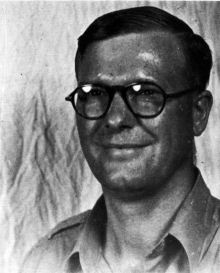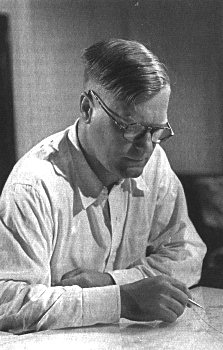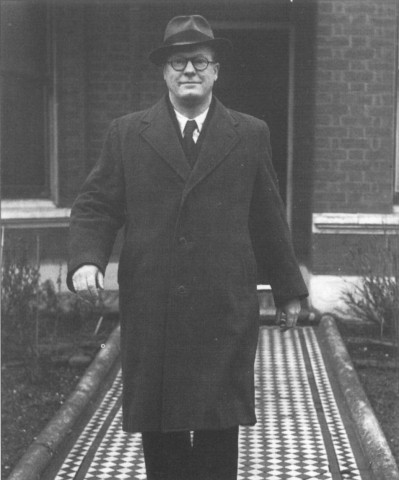<Back to Index>
- Physicist William George Penney, 1909
- Poet Samuel Ampzing, 1590
- Social Democratic Leader Victor Adler, 1852
PAGE SPONSOR



William George Penney, Baron Penney OM, KBE (24 June 1909 – 3 March 1991) was a British physicist who was responsible for the development of British nuclear technology following World War II. A mathematician by training, he became an expert on wave dynamics. He was one of the world's leading authorities on the effects of nuclear weapons; and he was tasked with the development of the British atomic bomb.
The son of a sergeant major in the Royal Army Ordnance Corps, Bill Penney was born in Gibraltar on 24 June 1909, and grew up in Sheerness, Kent, and attended the Colchester Royal Grammar School. From 1924 to 1926, he was educated at Sheerness Technical High School for Boys where he displayed a marked talent for mathematics.
In 1927, while working as a laboratory assistant, his mathematical ability gained him a scholarship to the Imperial College of Science, Technology and Medicine. He was awarded the Governor's Prize for Mathematics and graduated with a B.Sc. with First Class Honours in 1929 at age 20. Continuing his studies at the University of London, he obtained his Ph.D. in 1931 at age 22. He spent two years in the United States at the University of Wisconsin – Madison as a Commonwealth Fund Fellow. He returned to England and with the award of the 1851 Exhibition Scholarship he attended Trinity College, Cambridge, where he carried out theoretical investigations on the structure of metals and the magnetic properties of crystals. He obtained a doctorate from the University of Cambridge in 1935 on the application of quantum mechanics to the physics of crystals. In 1936, he was elected to the Stokes studentship at Pembroke College, Cambridge, but in the same year he returned to London and was appointed Reader in Mathematics at Imperial College London, a post he held from 1936 to 1945. His real love was mathematics and pure research in physics. As a recognised prodigy at Imperial College he was set for a distinguished academic career until World War II intervened.
Penney's area of scientific specialty was the physics of hydrodynamic waves, both shock waves and gravity waves. During the early years of World War II, he was loaned out to the Home Office and the Admiralty where
he investigated problems connected with the properties of under water
blast waves from high explosives, a subject of great importance in
designing ships and torpedoes. Penney designed and supervised
development of the Mulberry harbours that would be placed off the Normandy beaches during the D-Day invasion. These mobile breakwaters would protect the landing craft and troops
from the Atlantic rollers. In 1943, he was released from his duties at
Imperial College to work on the Tube Alloys project, and shortly before D-Day in 1944 he returned to America to work at Los Alamos as part of the British delegation to the Manhattan Project. On
the Manhattan Project, Penney worked on the use of the atomic bomb, its
effects and in particular the height at which it should be detonated.
He quickly gained recognition for his varied talents, his technical and
policy skills, his leadership qualities, and for his ability to work in
harmony with others. Within a few weeks of his arrival he was added to
the core group of scientists who made all key decisions in the
direction of the program. Other members of that team included J. Robert Oppenheimer, Captain William Parsons (USN), John von Neumann and Norman F. Ramsey. One
of Penney's assignments at Los Alamos was to predict the damage effects
from the blast wave of an atomic bomb. On 16 July 1945, Penney was an
observer at the Trinity test detonation.
He was there to observe the effect of radiant heating in igniting
structural materials, and had also designed apparatus to monitor the
blast effect of the explosions. The Americans considered him to be
among the five most distinguished British contributors to the work.
General Leslie Groves, overall director of the Manhattan Project, later wrote: vital
decisions were reached only after the most careful consideration and
discussion with the men I thought were able to offer the soundest
advice. Generally, for this operation, they were Oppenheimer, Von
Neumann, Penney, Parsons and Ramsey. Penney
went to Washington for a top secret meeting for a committee target
selection. He recommended Hiroshima and Nagasaki because of the hills
surrounding the environs which he said would create maximum
devastation. He gave valuable advice to the height of the bomb
detonation so that the fireball would not touch the earth and also for
no permanent radiation contamination on the ground. The U.S. nuclear team repeatedly attempted to recruit Penney as a permanent member, without success. Along with RAF Group Captain Leonard Cheshire, he accompanied the American Team to Tinian Island from which the Hiroshima and Nagasaki missions
were flown. On 9 August 1945 he witnessed the bombing of Nagasaki. The
US authorities had controversially stopped them seeing the Hiroshima
detonation, but at the last minute Penney and Cheshire were granted
permission to fly in the B-29 Big Stink, one of the observation planes that accompanied the Nagasaki mission bomber Bockscar. Due to the belated permissions, Big Stink missed
its rendezvous with the bomber at Nagasaki. They did see the Nagasaki
detonation from the air at a distance, making him one of the few people
in the world to witness first-hand either of the Japanese detonations
from the air. As the leading expert on the effects of nuclear weapons,
Penney was a member of the team of scientists and military analysts who
entered Hiroshima and Nagasaki following the Japanese surrender 15
August 1945 to assess the effects of the nuclear weapons. At the end of the war the British government, now under Labour Prime Minister Clement Attlee, believed that America would share the technology that British leaders saw as a joint discovery under the terms of the 1943 Quebec Agreement.
In December 1945 PM Attlee ordered the construction of an atomic pile
to produce plutonium and requested a report to detail requirements for
Britain's atomic bombs. Penney returned to England and intended to
resume his academic career, but was approached by C.P. Snow and asked to take up post as Chief Superintendent Armament Research (CSAR, called "Caesar") at Fort Halstead in
Kent, as he suspected Britain was going to have to build an atomic bomb
of its own and the government wanted Penney in this job. As CSAR he was responsible for all types of armaments research. In 1946, at the request of General Leslie Groves and the US Navy, Penney returned to the United States where he was put in charge of the blast effects studies for Operation Crossroads. In July, he was present at Bikini Atoll in the Marshall Islands and
wrote the after action reports on the effects of the two A-Bomb
detonations. His reputation was further enhanced when, after the
sophisticated test gauges failed, he was able to determine the blast power
using observations from simpler devices. However the passing of the McMahon Act (Atomic
Energy Act) by the Truman administration in August 1946 made it clear
that Britain would no longer be allowed access to US atomic
research. So Penney left the United States and returned to England
where he initiated his plans for an Atomics Weapons Section, submitting
them to the Lord Portal (Marshal
of the Royal Air Force) in November 1946. During the winter of
1946 - 1947, Penney returned once again to the United States, where he
served as a scientific adviser to the British representative at the
American Atomic Energy Commission.
With almost all other aspects of atomic co-operation between the
countries at an end, Penney's personal role was seen as keeping the
contact alive between the parties. Attlee's
government decided that Britain required the atomic bomb to maintain
its position in world politics. In the words of Foreign Secretary Ernest Bevin - "We've got to have it and it's got to have a bloody Union Jack on it." Officially,
the decision to proceed with the British atomic bomb project was made
in January 1947 - however arrangements were already under way. The
necessary plutonium was on order from Harwell and in the Armaments Research Department of the Ministry of Supply, an Atomic Weapons Section was being organised. The project was based at the Royal Arsenal, Woolwich, and was code-named High Explosive Research (or HER). In
May 1947, Penney was officially named to head the HER project. The
following month Penney began assembling teams of scientists and
engineers to work on the new technologies that had to be developed. In
June 1947, Penney gathered his fledgling team in the library at the
Royal Arsenal and gave a two-hour talk on the principles of the atomic
bomb. Centered at Fort Halstead, the work proceeded on schedule and, in
1950, it was realised that arrangements had to be made to test the
first bomb, since it would be ready within two years. Due
to the work being spread across a number of test facilities in the UK,
that were linked to the project with confusing lines of authority and
responsibility, it was realized that a single site was required. The
bomb design was also complex and innovative - although it started off
based on the design established with the Nagasaki bomb, it used
completely new methods of arming and of electrical detonation. In April
1950 an abandoned WWII airfield, RAF Aldermaston in
Berkshire was selected as the permanent home for Britain's nuclear
weapons programme. Construction began and in 1951 the first scientific
staff arrived at Aldermaston - soon after this, the HER project vacated
the Royal Arsenal. On 3 October 1952, under the code-name "Operation Hurricane", the first British nuclear device was successfully detonated off the west coast of Australia in the Monte Bello Islands.
This was a remarkable achievement and confirmed the qualities of
scientific ability and leadership skills of Penney. On his return to
England, Penney received a knighthood from Queen Elizabeth II. He
was also aware of the public relations issues associated with the
tests, and made clear speaking presentations to the Australian press. Before one series of tests the Australian High Commissioner described
his press presence: "Sir William Penney has established in Australia a
reputation which is quite unique: his appearance, his obvious sincerity
and honesty, and the general impression he gives that he would rather
be digging his garden – and would be, but for the essential nature of
his work – have made him a public figure of some magnitude in
Australian eyes". In 1953, he was offered a Chair at the University of Oxford but
declined in order to continue work on nuclear technology as director of
the Aldermaston site which was now officially named the Atomic Weapons Research Establishment (AWRE).
In 1954, nuclear development was transferred from the Ministry of Supply (MoS) to the newly formed United Kingdom Atomic Energy Authority (UKAEA).
From 1954 to 1967, Sir William served on the UKAEA Board, becoming
Chairman in 1962. Under his leadership the first British hydrogen bomb
was developed and tested in May 1957.
The Rt Hon Lord Penney, OM, KBE, MA, PhD, DSc, HonFCGI, FIC, FRS, was Rector of Imperial College London from 1967 - 1973. The college built and named the William Penney Laboratory after him. Additionally, he has a Hall of Residence named after him at Imperial College's campus in Silwood Park, near Ascot. In later years he admitted to qualms about his work but felt it was necessary. When aggressively questioned by the McClelland Royal Commission investigating
the test programmes at Monte Bello and Maralinga in 1985, he
acknowledged that at least one of the 12 tests probably had unsafe
levels of fallout. However he maintained that due care was taken and
that the tests conformed to the internationally accepted safety
standards of the time, a position which was confirmed from official
records by Lorna Arnold. McClelland broadly accepted Penney's view but anecdotal evidence to the contrary
received wide coverage in the press. By promoting a more Australian
nationalist view, then current in the government of Bob Hawke, McClelland had also identified "villains" in the previous Australian and British administrations. As
a senior witness Penney bore the brunt of the allegations, and his
health was badly affected by the experience. He died a few years later
at his home in the village of East Hendred, at the age 81. In his obituary in the New York Times he was credited as the father of the British atomic bomb. The Guardian described him as its "guiding light", and
his scientific and administrative leadership was said to be crucial in
its successful and timely creation. His leadership of the team that
exploded the first British hydrogen bomb at Christmas Island was
instrumental in restoring the exchange of nuclear technology between
Britain and the USA in 1958, and he was credited as playing a leading
part in the negotiations which led to the treaty forbidding atmospheric nuclear tests in 1963. During his lifetime William Penney was made a Commonwealth Fund Fellow at University of Wisconsin – Madison (1932); Fellow of the Royal Society (1946); Fellow of the Royal Society of Edinburgh (1970). Among the honours he received was the Rumford Medal by the Royal Society (1966). For services to the United States, he was one of the first recipients of the United States Medal of Freedom (with Silver Palm), awarded by President Harry S. Truman. For his services to Britain he was awarded O.B.E. (1946); appointed to the Order of the British Empire as Knight Commander (1952); was awarded a life peerage taking the title Baron Penney, of East Hendred in the Royal County of Berkshire (1967); awarded the Order of Merit (1969). He served on the board of the United Kingdom Atomic Energy Authority (from 1954 – 1967) and became its Chairman (1962 – 1967).